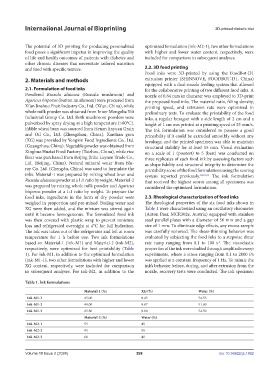Page 306 - IJB-10-2
P. 306
International Journal of Bioprinting 3D-printed diabetic diet
The potential of 3D printing for producing personalized optimized formulation (ink-M2-1), two other formulations
food poses a significant impetus in improving the quality with higher and lower water content, respectively, were
of life and health outcomes of patients with diabetes and included for comparison in subsequent analyses.
other chronic diseases that necessitate tailored nutrition
and food with specific texture. 2.2. 3D food printing
Food inks were 3D-printed by using the FoodBot-D1
2. Materials and methods extrusion printer (SHINNOVE, FOODBOT-D1, China)
equipped with a dual-nozzle feeding system that allowed
2.1. Formulation of food inks for the collaborative printing of two different food inks. A
Powdered Russula alutacea (Russula mushroom) and nozzle of 0.84 mm in diameter was employed to 3D-print
Agaricus bisporus (button mushroom) were procured from the proposed food inks. The material ratio, filling density,
Xi’an Jinshuo Fruit Industry Co., Ltd. (Xi’an, China), while printing speed, and extrusion rate were optimized in
whole milk powder was obtained from Inner Mongolia Yili preliminary tests. To evaluate the printability of the food
Industrial Group Co. Ltd. Both mushroom powders were inks, a regular hexagon with a side length of 2 cm and a
pulverized by spray drying at a high temperature (>80°C). height of 1 cm was printed at a printing speed of 25 mm/s.
Edible wheat bran was sourced from Henan Jinyuan Grain The ink formulation was considered to possess a good
and Oil Co., Ltd. (Zhengzhou, China). Xanthan gum printability if it could be extruded smoothly without any
(XG) was provided by Yongxin Food Ingredients Co., Ltd. breakage, and the printed specimen was able to maintain
(Guangzhou, China). Vegetable powder was obtained from structural stability for at least 15 min. Visual evaluation
Xinghua Huatai Food Factory (Taizhou, China), while rice on a scale of 1 (poorest) to 5 (best) was conducted on
flour was purchased from Beijing Jinhe Luyuan Trade Co., three replicates of each food ink by assessing factors such
Ltd. (Beijing, China). Natural mineral water from Blu- as shape fidelity and structural integrity to determine the
ray Co. Ltd. (Chengdu, China) was used to formulate the printability score of the food formulations using the scoring
inks. Material-1 was prepared by mixing wheat bran and system reported previously. 18,21,35 The ink formulation
Russula alutacea powder at a 1:1 ratio by weight. Material-2 that received the highest scores among all specimens was
was prepared by mixing whole milk powder and Agaricus considered the optimized formulation.
bisporus powder at a 1:1 ratio by weight. To prepare the
food inks, ingredients in the form of dry powder were 2.3. Rheological characterization of food inks
weighed in proportion and pre-mixed. Boiling water and The rheological properties of the six food inks shown in
XG were then added, and the mixture was stirred again Table 1 were characterized using an oscillatory rheometer
until it became homogeneous. The formulated food ink (Anton Paar, MCR302e, Austria) equipped with stainless
was then covered with plastic wrap to prevent moisture steel parallel plates with a diameter of 50 mm and a gap
loss and refrigerated overnight at 4°C for full hydration. size of 1 mm. To eliminate edge effects, any excess sample
The ink was taken out of the refrigerator and left at room was carefully removed. The shear-thinning behavior was
temperature for 1 h before use. Two ink formulations evaluated by subjecting the food inks to a stepwise shear
-1
based on Material-1 (ink-M1) and Material-2 (ink-M2), rate ramp ranging from 0.1 to 100 s . The viscoelastic
respectively, were optimized for best printability (Table properties of the ink were studied through amplitude sweep
1). For ink-M1, in addition to the optimized formulation experiments, where a stress ranging from 0.1 to 2000 Pa
(ink-M1-1), two other formulations with higher and lower was applied at a constant frequency of 1 Hz. To mimic the
XG content, respectively, were included for comparison ink’s behavior before, during, and after extrusion from the
in subsequent analyses. For ink-M2, in addition to the nozzle, recovery tests were conducted. The ink specimen
Table 1. Ink formulations
Material-1 (%) XG (%) Water (%)
Ink-M1-1 45.00 0.45 54.55
Ink-M1-2 48.00 0.07 51.90
Ink-M1-3 45.50 0.00 54.50
Material-2 (%) Water (%)
Ink-M2-1 55 45
Ink-M2-2 45 55
Ink-M2-3 60 40
Volume 10 Issue 2 (2024) 298 doi: 10.36922/ijb.1862

